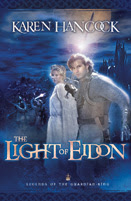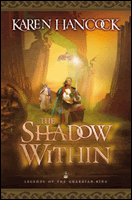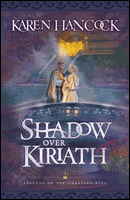 So, if I want to portray God in allegorical fashion, it’s okay if He shows up as a human father (or animal father) in a story, but not if he shows up as… well… God. The problem is, I know God exists. I believe that Jesus Christ is the second person of the trinity, took on the form of a man and came to earth to die for my sins. I love that. But that’s not really want I want to analogize. Those seem to me to be obvious, basic truths. I want to go farther than that. I want to analogize elements of the Christian life in order to get more at the truths embodied there. And to do that, it’s much easier on everyone if you just start out with God as God, or Eidon, in this case, and go from there.
So, if I want to portray God in allegorical fashion, it’s okay if He shows up as a human father (or animal father) in a story, but not if he shows up as… well… God. The problem is, I know God exists. I believe that Jesus Christ is the second person of the trinity, took on the form of a man and came to earth to die for my sins. I love that. But that’s not really want I want to analogize. Those seem to me to be obvious, basic truths. I want to go farther than that. I want to analogize elements of the Christian life in order to get more at the truths embodied there. And to do that, it’s much easier on everyone if you just start out with God as God, or Eidon, in this case, and go from there.So maybe I don't write allegory at all. Maybe what I do, as one of my friends suggested, is make the invisible visible.
 The Christian life is largely invisible, since the most important aspects of it reside in the mind. Motivation matters more than what is actually done. Do good things in the wrong power system and it turns out to be wood, hay, straw. We can’t see what’s in each other’s hearts… so what looks to us like good might actually be failure and often what looks like failure (I’m thinking of the cross in particular) is great victory. The battle we face as Christians is also largely invisible. It’s not against people, “but against the rulers, against the powers, against the world forces of this darkness, against the spiritual forces of wickedness in the heavenly places.” It's really hard to fight a battle when you can't see the enemy and don't know where he's coming from.
The Christian life is largely invisible, since the most important aspects of it reside in the mind. Motivation matters more than what is actually done. Do good things in the wrong power system and it turns out to be wood, hay, straw. We can’t see what’s in each other’s hearts… so what looks to us like good might actually be failure and often what looks like failure (I’m thinking of the cross in particular) is great victory. The battle we face as Christians is also largely invisible. It’s not against people, “but against the rulers, against the powers, against the world forces of this darkness, against the spiritual forces of wickedness in the heavenly places.” It's really hard to fight a battle when you can't see the enemy and don't know where he's coming from.So here is what I do. I study the principles of the Christian life on a day by day basis. This is a vast amount of information, of which I retain a pathetically small amount, but nevertheless quite a body of material from which to draw. This I assimilate into my thinking and then try to apply to my life, usually a process akin to learning to ride bicycle: there’s lots of wobbling, falling down and messing up. It’s an ongoing process wherein I learn about myself, the principles, how exactly they apply, and God – who He is, how He operates, and how He deals with me.
As part of that process I find myself making analogies of how a certain principle in God's word is like some physical aspect of life. Eg, the believer at salvation is to be like a caterpillar upon hatching – it eats and eats and eats until one day it’s eaten enough that its body can form a cocoon or chrysalis. Thus protected, its insides turn to mush and then reform into a butterfly…. (Lately I’ve been relating a lot to the mush part). I do this a lot as part of my own way of understanding truth, life and how it all fits together.
My stories are an outworking of this function. Fantasy is full of great analogous tropes, and so I’ve chosen it for the foundation of my work. The essay, In Defense of Fantasy on my website goes into this in detail so I won’t here. I enjoy using those stock elements in building a story that can fairly directly communicate what I’ve learned and what I value.
Of course life and especially the spiritual life is far too vast, complex and mysterious to be able to codify all the elements in a tidy, coherent one for one pattern. Even assuming I could understand it all, which I can’t. So I set up a few general parameters for the world and the magic, parameters that reflect essential truths in our real world, and go from there.
 In Legends of the Guardian King, these include Eidon, Tersius, Moroq, the Light, the golden shield, rhu’ema, rhu’ema spawn and spore. This is my playground, as it were, and from there I start to build my story and world. At this point all the things I’ve chosen now have to be developed into something visible. Fleshed out, given background, interconnections, logical ramifications… Which is pretty standard world building/plotting practice.
In Legends of the Guardian King, these include Eidon, Tersius, Moroq, the Light, the golden shield, rhu’ema, rhu’ema spawn and spore. This is my playground, as it were, and from there I start to build my story and world. At this point all the things I’ve chosen now have to be developed into something visible. Fleshed out, given background, interconnections, logical ramifications… Which is pretty standard world building/plotting practice.That’s mostly a side issue though, because what I’m really interested in are the characters and their relationships with each other and with God. Most of the things I portray and struggles I deal with are reminiscent of struggles I’ve gone through and of the ways I’ve resolved them. Or else the ways I think I would resolve them.
And even all of this sounds way more cognizant that it seems in practice. (I feel like that caterpillar trying to explain how it walks.) Here’s what happens when I sit down to write. I know that the world of Eidon is different from ours, and yet for me, somehow, it’s the same. I’m made a different world, with creatures, physical laws, histories and spiritual aspects that are not our world. But similar to it. So I write it, and it relates and yet it doesn’t. I’m making visible what is invisible in our world. By that token it’s one for one. But I don’t sit down and plan it all out. More times than I wish things just appear in the story and I sit back and ask “What’s up with this? Where is this supposed to go?” Usually I think it’s cool, whatever it is, and conclude that the Lord has some purpose in it, so I let it stay and move on, trusting that eventually its place and purpose will become clear.
And eventually, for the most part, it does all come together. At least sufficiently to satisfy me, if not all my readers. :-)
Grace,
Karen

